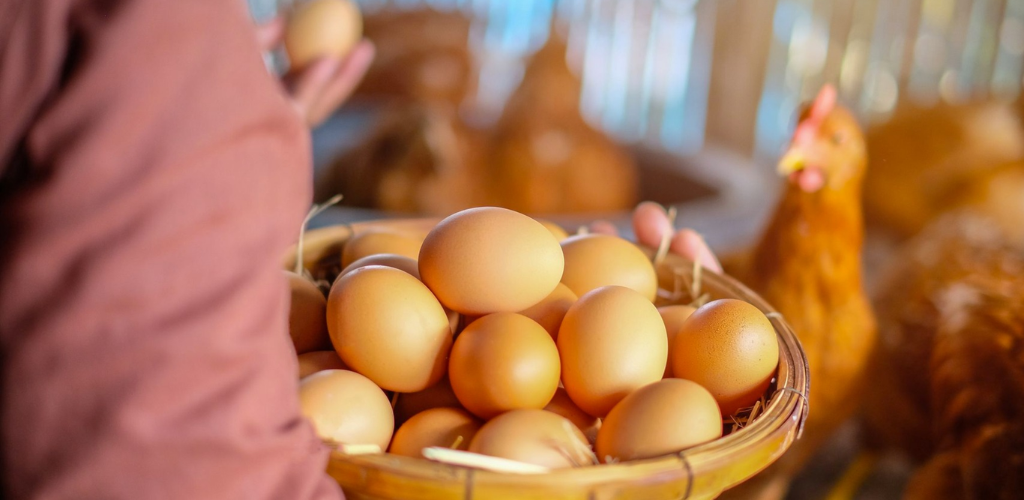Do you feed your chickens? Feed them this and they will lay MANY MORE EGGS!
How to feed chickens, how many times a day, what supplements to choose and how to achieve year-round egg production – these are all questions that beginner farmers who have decided to raise laying hens ask themselves.
The quantity and quality of eggs depend on the diet of the hens.
Allow yourself to receive advice and trust the recommendations of the retete-usoare portal.
Don’t expect chickens to lay eggs continuously on grass alone.
At the same time, it is not appropriate to feed chickens exclusively with grains.
Excellent mixed feeds for poultry are a no-brainer, making the job of their owners easier and saving them from worrying about the correct composition.
However, this solution is expensive and not everyone can afford it.
If you want to prepare your own food for your chickens, create a balanced menu with products you can buy or grow in your own garden.
Layers should consume at least 130-180 g of balanced feed daily.
What to feed layers? The diet of hens depends on the purpose of breeding, as well as the age of the birds.
Feeding chicks and broilers is a separate topic, and here we will talk more about feeding layers.
Regardless of the age of the chickens, they should always have access to these products:
bone meal, fish meal, washed river sand with a grain diameter of approximately 5 mm and calcium grit.
In addition, it is good to provide birds with at least a few hours of outdoor walking to find worms, caterpillars, roots and vegetation.
Feeding chicks up to 5 months Up to 5-6 months of age, chickens rarely lay eggs, as they are in the process of growing and gaining strength.
During this period, the main task of the farmer is to raise healthy birds.
Emphasis is placed on proteins and vitamins.
The diet for birds should include mixtures of cereals, vegetables, bone meal and mineral supplements.
The proportion for each bird is calculated as follows:
- cereal mix – 50 g;
- ground bone meal – 50 g;
- cooked or raw vegetables – up to 70 g;
- salt, mineral supplements – up to 6 g;
- proteins – 15-20 g.
The cereal mix contains 60-70% wheat and 10% oats, rye and barley.
Feeding chickens from 5 months to 1 year At around 6 months, chickens begin to lay eggs, so feed or foods with a higher calcium content are added to the regular diet.
During this period, many poultry breeders switch to combined feeding, but you can also limit yourself to purchasing feed supplements for layers.
At this time, a quality outdoor area is especially important for birds.
Feeding chickens after 1 year After one year, the number of eggs laid decreases.
It is a natural process, which is why experienced farmers change the hens.
If you do not need eggs for sale, but only for personal consumption, this period can be extended by adjusting the diet of the hens.
The mixture is enriched with pumpkin, sunflower, minced fish, chopped vegetables and vitamin complexes.
In addition, some of the grains are allowed to germinate before being used for food.
If you spread sprouted grains on a tray, the chickens will gladly select them.
Unfortunately, after 2 years, even purebred hens begin to lay fewer eggs.
Breeding birds no longer makes sense, so at this point you should have replacements bred.
How often should you feed chickens?
Healthy, large chickens should be fed twice a day, morning and evening, with the same amount of feed. They should also have constant access to water and supplements.
If egg production has decreased and is not related to age, it is time to strengthen the diet. Start feeding the hens four times a day, providing dry mixes in the morning and evening, and warm, moist mixes at 11:00 and 16:00.
How to feed chickens in winter? The lack of outdoor walks and sunlight during the winter lead to a decrease in egg production. You can compensate for this with additional care and proper nutrition. In winter, the air temperature in the chicken coop should be at least 15°C, and the lighting should be at least 8-9 hours.
Boiled potatoes, dried and boiled nettles, and finely chopped vegetables (pumpkin, carrot, beetroot, zucchini, etc.) are added to the usual grain mixtures. Mix everything well and add 10 grams of yeast, 3 grams of fish oil and 2-3 grams of salt per kilogram of feed. Chickens should be fed twice a day, in the morning and in the evening, with this mixture.
What not to feed chickens? Many people have a vague idea about chicken feed and believe that all table scraps, including spoiled food, can be fed to chickens. Unfortunately, this is not the case: such spoiled food can cause illness and even death in chickens.
Your diet should never include:
- Fresh bread with yeast or moldy bread (dry bread is allowed);
- Sour soups;
- Spoiled meat and fish;
- Wormwood, bear’s garlic and leaves of poisonous shrubs;
- Cereals treated with chemicals;
- Garlic, onion (can be harmful to chickens);
- Raw beans, avocado, sprouted potato peels (toxic to chickens);
- Banana peels;
- Leek;
- Sweets;
- Mayonnaise;
- Unshelled walnuts.
